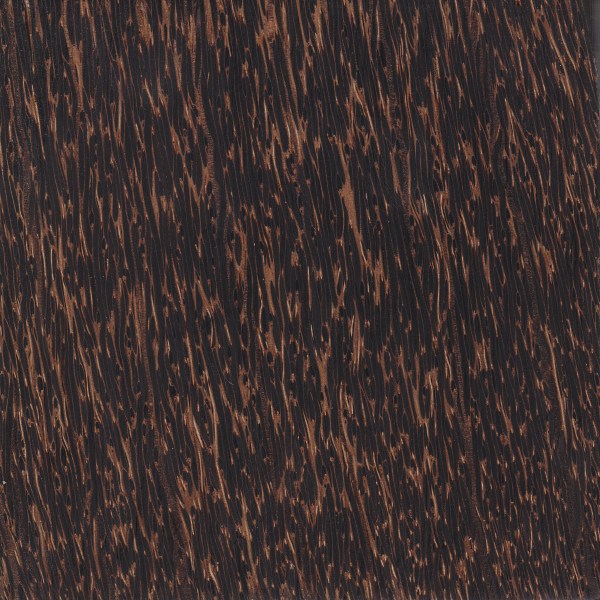Black Palm
How the Wood Scale Works
The scale above displays the measured values for this species of wood compared to Oak – a wood species most people are familiar with.
The red line shows the value for this wood, while the tan line represents the baseline value for Oak.
Common Names:
Black Palm, Palmyra Palm
Scientific Names:
Borassus flabellifer
Appearance:
Black fibers embedded in a lighter tan or light brown colored body. Fibers are more densely packed toward the outside of the tree trunk, becoming more and more sparse toward the center of the tree. The center core of the tree is soft and contains none of the darker vascular bundles that give the wood its characteristic look and hardness. (This is nearly opposite of the typical outer sapwood/inner heartwood combination found in dicot hardwoods.)
Grain:
Black Palm has a medium to fine texture, though it is by no means even or uniform on account of the contrast between the dense, darker fibers, and the soft, lighter cellulose structure of the wood. Grain is very straight, and contains no growth rings, knots, or defects.
Durability:
Black Palm is reported to be durable regarding decay resistance, though it is susceptible to insect attacks.
Scent:
There is no characteristic odor associated with this wood species.
Safety:
Palms in the Arecaceae family have been reported to cause skin irritation, and general constitutional effects.
Availability:
Although Black Palm trees can get up to several feet across, the center of the trunk is filled with a soft, unfigured portion, with only the outer areas of the trunk containing the characteristic colored fibers, so only narrow boards and spindle-stock are normally available. Prices for most sizes of Black Palm should be in the moderate range for an imported tropical wood.
Other Comments:
Technically neither a softwood nor a hardwood, palm falls into the category of monocots, which also includes bamboo, grass, banana, rice, wheat, corn, etc. (Monocot is short for monocotyledon, which simply means that the seed of the plant contains one leaf, rather than two as found in dicots.) Palm woods have no growth rings, and as a result, the shrinkage rate for drying the wood is more or less uniform between the radial and tangential surfaces, resulting in a T/R ratio of 1.0 and good dimensional stability. Black Palm is highly variable in weight, strength, and hardness properties because the wood is so non-homogenous: the trunk is a gradient between the strong fibrovascular bundles, and the softer cellulose structure. Toward the outer wall of the trunk, the density of the wood is the greatest, and gradually becomes lighter, softer, and weaker towards the soft core. Because of this great variability, the density of Black Palm can range from less than 25 lbs/ft3 (400 kg/m3), to over 62 lbs/ft3 (1000 kg/m3)—where it will actually sink in water. A quick visual inspection of prospective wood blanks can help screen out undesired pieces: darker wood usually has a denser packing of fibers, and tends to produce heavier, stronger, and harder material. Some common uses for Black Palm include: flooring, boatbuilding, walking sticks, knife and tool handles, rafters, furniture, and turned objects.

